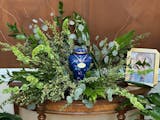by J. Malec

C.A. Beal is author of Be a Tree: the Natural Burial Guide for Turning Yourself into a Forest. Beal advocates primarily for a shift away from traditional burial methods. She urges practices such as planting cremation ashes with a tree.
In her book Beal discusses traditional cemeteries. “The box is pretty, the lawns are neat, and nature can't get a word in edgewise.” She, like many, believe that we owe it to future generations to stop putting millions of gallons of toxic embalming fluid, as well as billions of tons of concrete, hardwood, steel, copper and brass into the ground every year, where they pollute groundwater and waste precious resources.
Cremation urns such as the Acorn Biodegradable Cremation Urn are uniquely designed with the environment in mind. The natural fibers decompose rapidly. The eco-friendly NatureUrn® is also designed to be kind to our earth.
Why do people choose to plant cremation ashes with a tree?
There are many reasons why you might choose to be planted post-mortem, just a few of which are touched on here.
Beal’s call to action urges that the creative challenge of the 21st century is rising to meet end of life challenges in a green way. She encourages us to find solutions that “support the values of greenspace preservation, carbon sequestration, habitat creation, nutrient cycling, and brownfields reclamation. … The demand to ‘Leave No Trace’ is increasing.” Her conclusions ultimately point toward embracing “natural burial” (unpreserved, unboxed and allowed to decompose naturally).
Creating a Memorial Planting
There are products available to plant cremation ashes with a seedling or seeds. Some manufacturers claim that the planting is as simple as “just-add-ashes.” But as any experienced gardener will tell you, successfully growing plants is rarely as simple as plant-it-and-forget it. This can be seen as a positive point for memorial plantings and gardens.
Tending to the health of your planting will help you feel more connected and close to your loved one after his or her passing. Adding outdoor garden furniture or a birdhouse or two may complete a type of meditation sanctuary. The defined space can become a place where you commune with nature’s spirit and the spirit of the remembered.
Another benefit of natural burials is cost. Natural burials are less expensive because there is less material used, less energy consumed and fewer processes involved. Like the natural birth movement, there is now a movement emerging around a natural death, and an extension of that philosophy is the natural burial. “Death doulas” offer services similar to those offered by birth doulas, but at the other end of life. Death doulas believe it’s important to remember that we are all a part of something greater, a cycle of living and dying.
Maybe it’s the Western world’s view, or maybe the age we live in, but we have lost the sense of interconnectedness that once allowed us to breathe our last breath in peace. Knowing that one’s body returns to nature, and even contributes to a continuation of life, can be a comfort in the face of the unknown. Imagining oneself as a tree after life, and then choosing its seed can be a comfort when we feel powerless. Meditating on the birds that will make homes in our new branches, or on the bees that will pollinate our flowers can be a way of overcoming discomfort of the inevitable.
These days, end of life decisions can be as unique as you are. There is no one-size-fits-all memorial anymore. As cremation continues to gain traction among the baby-boomer generation, chief among reasons given for opting-out of a traditional burial is concern for the environment and a wish to contribute to nature’s web of life.
J. Malec is a visual artist and writer whose work often deals with themes related to loss and healing. She lives in Minneapolis, and spends much of her time practicing permaculture in the city.


